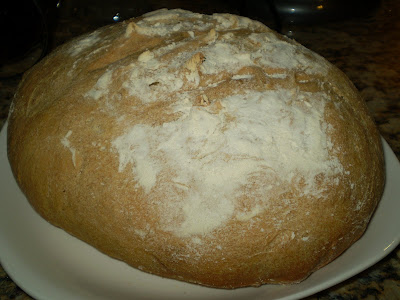
Now I'm not expecting you to be nearly as nerdy/masochistic as I am and spend two days making your own homemade focaccia. But hey, if you have the mixer and the patience, let your bread freak flag fly. Because the focaccia recipe below, courtesy of
Baking with Julia, is some of the best bread I've ever eaten. Which, by the way, only strengthens my credo that olive oil makes everything,
everything, better. Gotta love those Italians.
In addition to Katie's purist version of focaccia enjoyment above, these loaves are also excellent for sandwiches. The old man particularly loved when I sliced a big piece in half, smeared it with hummus, and topped it with chopped olives, fresh mozzarella and greens. (In fact, I believe his exact words were, "This is the best f-ing sandwich ever.")
So go forth and bake, my friends, and let me know how it turns out. And please, send along any favorite bread recipes you have, as this nerd is going to need her fix again soon.
 Focaccia
Focaccia2 ¼ to 2 ½ cups tepid water (about 90 degrees)
2 tbsp active dry yeast
¼ cup olive oil
6 ½ cups unbleached all-purpose flour (I love King Arthur’s brand)
4 tsp salt
Mixing the dough: Whisk ½ cup of the water and the yeast together in the bowl of a mixer. Set the mixture aside for 5 minutes, until the yeast dissolves and turns creamy.
Meanwhile, pour 1 ¾ cups warm water into a large measuring cup, add the olive oil, and whisk to blend; sets aside. Whisk the flour and the salt together in a large bowl and set this aside as well.
Pour the water-oil mixture over the yeast and stir with the whisk to blend. Add about half of the flour and stir with a rubber spatula just to mix. Attached the dough hook, add the remaining flour, and mix on low speed for about 3 minutes, or until the dough just starts to come together. If the dough appears dry or a little stiff, add a few drops of warm water, scraping the bowl and hook if necessary to incorporate the water and create a soft dough. Increase the mixer speed to medium-high and continue to mix for about 10 minutes, scraping down the hook and sides of the bowl as needed, until you have a soft, slightly moist, extremely elastic dough that cleans the sides of the bowl.
First rise: Transfer the dough to a work surface and form it into a ball. Place the dough in an oil bowl, turn it around to cover it with oil, and cover the bowl tightly with plastic wrap. Allow the dough to rise at room temperature until doubled in bulk, about 1 to 1 ½ hours.
Second rise: Fold the dough on itself to deflate it and let it rise again until doubled and billowy, 45 minutes to an hour.
Shaping and resting: Fold the dough over on itself again to deflate it (as you do this, you can hear the bubbles squeak and pop) and turn it out onto a work surface. Using a metal dough scraper or a knife, cut the dough into 3 equal pieces. Shape each piece into a ball.
The dough needs to be refrigerated for between 24 and 36 hours. (It is this long refrigerated rest that gives the focaccia its characteristic chewy texture and surface bubbles). Place each ball into an oiled gallon-size zip lock bag and refrigerate.
About 1 ½ hours before you plan to bake, remove the dough from the fridge and gently take the balls out of the bags. Place the dough on a lightly floured surface, dust the tops of the balls with flour, then cover loosely but completely with plastic wrap to keep the tops from getting crusty. Let rest for 1 hour, until the dough reaches a cool room temperature.
The Topping:
Olive oil
2-3 tbsp chopped fresh herbs, such as rosemary and/or thyme
Coarse sea salt
Position an oven rack in the lower third of the oven and preheat to 450. Line two baking sheets with parchment paper and sprinkle with cornmeal.
Shaping the dough: Use your palm to press down gently on each piece of dough, causing bubbles to appear on the sides, then slit the bubbles with a knife. Gently pull and stretch each piece of dough int a square about 10 inches across, taking care not to overwork the dough. Let the dough relax, covered, for about 10 minutes.
Baking the bread: Transfer the focaccias to the baking sheets. Brush the focaccias with oil, sprinkle with herbs and sea salt, and put them in the oven. Bake the breads for 15-20 minutes, or until they are golden with heavy speckling of small surface bubbles. (If you have a water bottle, spray the oven three times with water during the first eight minutes of baking. This creates steam which helps the focaccia bake properly. FYI – like most people, I don’t have a random spray bottle just lying around, so I skipped this step). As soon as you remove the focaccias from the oven, brush them with a little additional olive oil and transfer them to a rack to cool before serving.
Storing: The focaccias are best the day they are baked, but once cooled, they can be wrapped airtight and frozen for up to 2 weeks. Thaw the breads, still wrapped, at room temperature and warm them in a 350 oven before serving.
 Some people wait all year for sweet spring asparagus. Some for the fruits of summer. I wait for potato pancakes.
Some people wait all year for sweet spring asparagus. Some for the fruits of summer. I wait for potato pancakes.

 Preheat the oven to 450 degree.
Preheat the oven to 450 degree.
 2 cups all purpose flour
2 cups all purpose flour 























 2 tbsp olive oil
2 tbsp olive oil


















